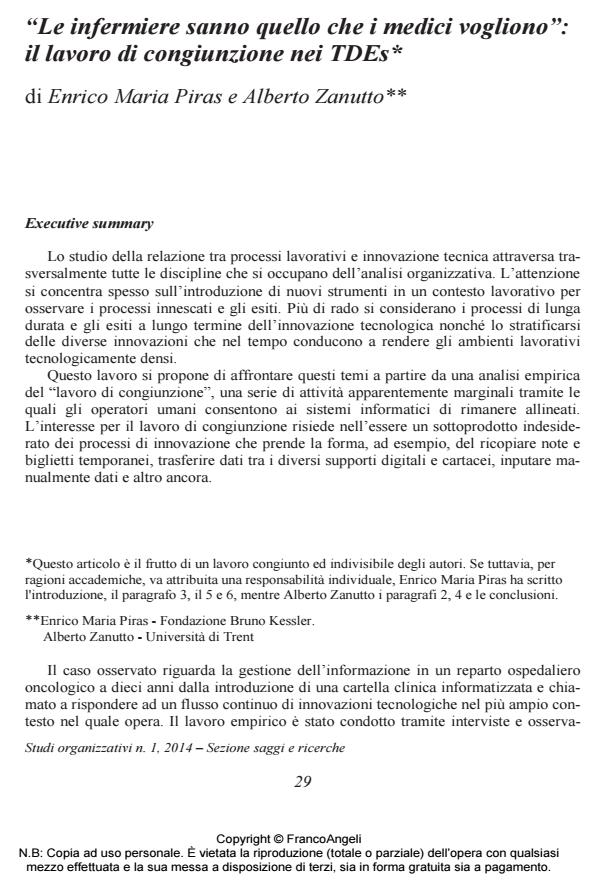"Le infermiere sanno quello che i medici vogliono": il lavoro di congiunzione nei TDEs
Journal title STUDI ORGANIZZATIVI
Author/s Enrico Maria Piras, Alberto Zanutto
Publishing Year 2014 Issue 2014/1
Language Italian Pages 21 P. 29-49 File size 98 KB
DOI 10.3280/SO2014-001002
DOI is like a bar code for intellectual property: to have more infomation
click here
Below, you can see the article first page
If you want to buy this article in PDF format, you can do it, following the instructions to buy download credits

FrancoAngeli is member of Publishers International Linking Association, Inc (PILA), a not-for-profit association which run the CrossRef service enabling links to and from online scholarly content.
The relationship between work processes and technological innovations is a recurring theme of all the disciplines interested in organizational analysis. The majority of the studies focus on the introduction on new technologies to evaluate the effects of work organization while less common are the analysis of long term effects and of the stratification of technical artefacts that, over time, lead to the creation of Technologically Dense Environments. This work addresses these issues through an empirical analysis of "junction work", the array of apparently marginal activities performed by human actors to allow information systems to be aligned. The interest in junction work stems from its being considered a undesired by-product of innovation. Junction work takes the form of copying hand notes, transcribing data from one system to another (digital or paper-based), data inputting and so on. We present the case of information management in an oncological department ten years after the deployment of an electronic medical record and is based on qualitative interviews and participant observation aimed at discovering the origin of junction work, its analysis and the changes in the professional profile of the people that perform it. Results show that innovation process, guided by medical doctors, is intertwined with a delegation to nurses of a growing role as information managers. The overall outcome is the transformation of the ward into a technologically dense environments in the nurses experience, required to perform a constant junction work to ensure the information flow within the department and with the rest of the other facilities. Results therefore confirm how the cumulative effects of technological stratification have a different impact on organizational actors. Despite being represented as transient and accidental, junction work appears a constitutive element of technologically dense environments and it can therefore be considered as a useful unit of analysis to study them.
Keywords: Technologically dense environments, junction work, nursing, information systems.
- COOP 2016: Proceedings of the 12th International Conference on the Design of Cooperative Systems, 23-27 May 2016, Trento, Italy Enrico Maria Piras, Alberto Zanutto, pp.173 (ISBN:978-3-319-33463-9)
Enrico Maria Piras, Alberto Zanutto, "Le infermiere sanno quello che i medici vogliono": il lavoro di congiunzione nei TDEs in "STUDI ORGANIZZATIVI " 1/2014, pp 29-49, DOI: 10.3280/SO2014-001002